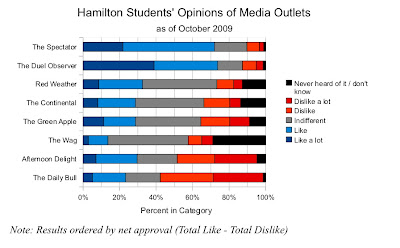By Kye Lippold, HamPoll Co-Chair
A survey conducted in early October 2009 by HamPoll found that the Spectator and Duel Observer were the most popular Hamilton publications, while the Daily Bull and the (now defunct) Afternoon Delight brought up the rear of students' acclaim.
We further analyzed the data by breaking down responses among demographic categories (specifically: gender, race, financial aid status, class year, location of hometown, living on the darkside or lightside, playing sports, being in a Greek society, and political leanings). The following groups of students were especially likely to read each publication (reading “most issues” or more) relative to other groups in each category:
• The Spectator was read most often by students in Greek societies (77% of Greeks read the Spec often, versus 58% of non-Greeks), and students from the Northeast (66% of local students versus 50% of others). Students on financial aid were less likely to read the Spectator (57%) than students without aid (65%).
• The Daily Bull was especially popular among Darksiders (37% frequent readers, versus 26% of others).
• Senior students were less likely to often read the Duel Observer (only 52%) than those in earlier class years (70%). The Duel was also slightly less popular among students of color (61%) than among white students (69%).
• Students in Greek societies were more likely to read the Continental (47% versus 32%). Firstyears and sophomores were less likely to read this publication (likely influenced by the fact that the survey was fielded before the Continental released that semester's issue).
• The Green Apple was not read often by any group; only liberals were marginally more likely to read it than moderate or conservative students, 26% versus 14%.
• Afternoon Delight was not much read by students of color, only 16% of whom read it often (versus 34% of white students).
• Red Weather was more popular among students on financial aid, 24% versus 14%.
• The Wag was the least read publication on campus, only read by 11% of students. This number was probably further decreased because the Wag had not published when this survey was fielded.
The survey received 411 responses, or about a 23 percent response rate. The survey sample was self-selected, so results may differ from the overall population; notably, women, white students, and non-athletes were overrepresented in our sample, although the sample very closely matched Hamilton student demographics in terms of geographic distribution.
Supplemental Graph



